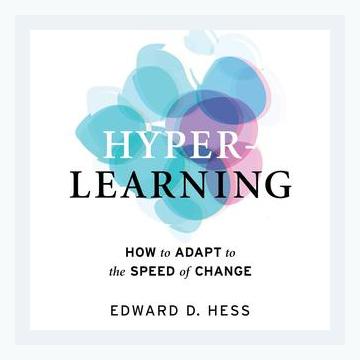Innovation and CreativityDisruptive Innovation
“Hyper-Learning: How to Adapt to the Speed of Change” by Edward D. Hess – Summary
Introduction
Edward D. Hess’s “Hyper-Learning: How to Adapt to the Speed of Change” delves into the pressing necessity for individuals and organizations to harmonize with the rapid pace of technological evolution and market disruptions. The book advocates for cultivating adaptive mental processes and holistic personal development to thrive in an era where change is the only constant. Hess meticulously outlines a framework for achieving Hyper-Learning, a state where continuous learning, unlearning, and relearning become ingrained behaviors. Below is an organized summary of the key points, coupled with actionable steps and examples from the book.
I. The Urgency of Hyper-Learning
Hess begins by setting the stage with a compelling argument for Hyper-Learning. The rapid obsolescence of skills due to technological advancements necessitates a paradigm shift in how we approach learning and adaptation.
Action Step:
– Develop a Growth Mindset: Embrace a mindset that views challenges as opportunities for growth rather than threats to competency.
Example:
– Hess cites Carol Dweck’s research on growth mindset, emphasizing the importance of believing that improvement is always possible. Companies like Microsoft have adopted this mindset at an organizational level, fostering environments where employees continually seek progress.
II. Cognitive Mastery: Tools and Techniques
The book outlines various cognitive mastery techniques essential for Hyper-Learning. These include critical thinking, reflective thinking, and managing cognitive biases.
Action Step:
– Practice Mindfulness: Regular mindfulness can enhance focus and metacognition.
Example:
– Google’s “Search Inside Yourself” program is highlighted, which combines mindfulness with emotional intelligence skills to improve employee performance and well-being.
III. Emotional Management
Hess stresses that managing emotions is crucial to adapting and thriving. An emotionally balanced state enables better decision-making and fosters stronger interpersonal relationships.
Action Step:
– Journaling Emotions: Keep an emotional journal to track and analyze emotional responses to different situations, leading to improved emotional self-regulation.
Example:
– In the book, Hess references Ray Dalio’s practice of logging daily reflections to better understand his emotional responses and biases, contributing to his success at Bridgewater Associates.
IV. Social and Emotional Engagement
Building trust and fostering collaboration is critical. Hess argues that Hyper-Learning occurs most efficiently in environments where psychological safety is paramount.
Action Step:
– Create Safe Spaces: Encourage open dialogue and create a non-judgmental environment in teams to facilitate uninhibited sharing of ideas.
Example:
– Hess uses the example of Pixar’s Braintrust sessions, where candid feedback sessions are a norm, enabling continuous improvement in their creative processes.
V. Redefining Work and Organizational Culture
A significant portion of the book focuses on restructuring organizational culture to support Hyper-Learning. Companies need to align their values and operations with the principles of continuous improvement and learning.
Action Step:
– Revamp Performance Metrics: Shift from traditional metrics to those that capture learning and development.
Example:
– Hess shares the transformative journey of Haier, a Chinese appliance manufacturer, which adopted a “zero distance” management philosophy that aligns customer needs with employee learning and innovation efforts.
VI. Building a Learning Ecosystem
Creating an ecosystem that nurtures Hyper-Learning involves leveraging technology, encouraging cross-disciplinary learning, and designing physical and virtual spaces conducive to learning.
Action Step:
– Integrate Learning Technology: Utilize tools and platforms that facilitate ongoing education and skill development.
Example:
– Hess discusses how Siemens has integrated virtual reality for training purposes, providing immersive learning experiences that significantly enhance skill acquisition.
VII. Individual Self-Development
Hess emphasizes personal responsibility in Hyper-Learning. Individuals must take active steps towards self-improvement and holistic development.
Action Step:
– Continuous Learning Plan: Create and regularly update a personal learning plan that includes goals, resources, and timelines.
Example:
– The book references the practice of “kaizen” or continuous improvement, implemented by executives at Toyota, who follow a personal development plan guided by small, incremental improvements.
VIII. Fostering Intellectual Humility
Admitting one’s limitations and being open to new perspectives is essential for Hyper-Learning. Intellectual humility involves recognizing the boundaries of one’s knowledge and being willing to learn from others.
Action Step:
– Seek Diverse Perspectives: Regularly engage with people who have different viewpoints and expertise to broaden understanding and challenge assumptions.
Example:
– Hess shares how IDEO, a design company, deliberately constructs teams from diverse backgrounds to foster innovation and holistic problem-solving.
IX. The Role of Leadership
Leaders play a pivotal role in cultivating a culture conducive to Hyper-Learning. Leadership should be characterized by authenticity, empathy, and a commitment to the development of their teams.
Action Step:
– Lead by Example: Leaders should model the behaviors and attitudes they wish to see, such as vulnerability, continuous learning, and open-mindedness.
Example:
– Hess discusses the approach of Satya Nadella, CEO of Microsoft, who transformed the company’s culture by embodying a growth mindset and emphasizing empathy.
X. Collaborative Learning
The book places substantial importance on collaborative learning. Hess argues that learning is often more effective and richer when done in a communal setting where ideas and feedback can be exchanged freely.
Action Step:
– Engage in Peer Learning: Participate in or create study groups, seminar discussions, or learning communities within and outside the workspace.
Example:
– The “collective genius” model at Google, where innovation is driven through intense collaboration and collective problem-solving, is highlighted in the book.
Conclusion
“Hess’s “Hyper-Learning” presents a thorough roadmap for individuals and organizations to adapt and excel in a fast-changing world. By fostering a culture of continuous learning and open-mindedness, embracing emotional management, and leveraging technology, Hyper-Learning becomes not just a strategy, but a way of life.
By meticulously following Hess’s structured approach to Hyper-Learning, individuals and organizations can prepare themselves to navigate and flourish within the tumultuous waves of modern technological and market disruptions.
